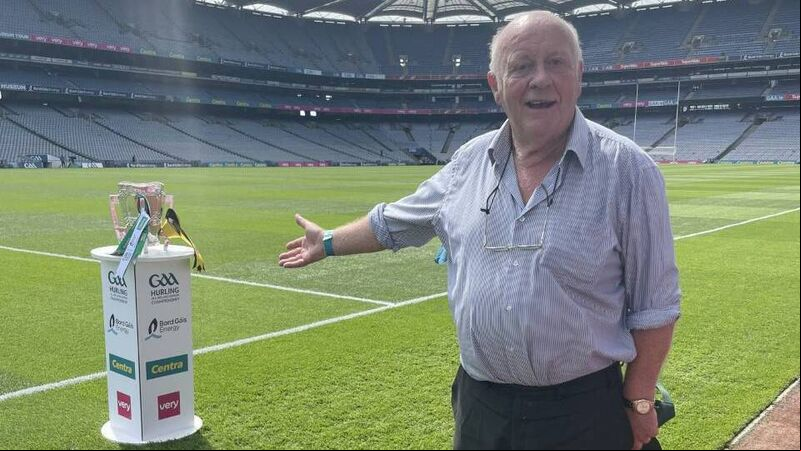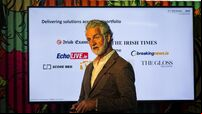My stroll alone at Croke Park, along with ghosts of our past

SO NEAR... YET SO FAR: John Arnold at Croke Park with the Liam MacCarthy Cup
Years back, when spring ploughing would start on our farm and on neighbouring land, these birds would arrive.
Youghal and Garryvoe, our closest beaches, are both about 20 miles away from us - places where seagulls normally live... or so I thought.
There might be only a few sods ploughed and turned over as the green field turned brown. Yet within minutes the worm-seeking crows would arrive, followed immediately by the flocks of white, raucous gulls.
I still can’t figure out how some ‘signal’ was communicated from inland fields to those birds by the sea which summoned them hether. In my mind it was down to some ancient, innate ‘seventh sense’ which the seagulls possess, allied to a degree of intelligence far beyond human logic.
It seemed they simply ‘knew’ the ploughing had begun and that meant abundant supplies of worms, grubs and other creepy crawlies.
Well, at 10am last Sunday in Croke Park, I revised my theory about the level of intelligence bestowed on seagulls - the Dublin variety at least.
Fifty years after seeing my first All Ireland Hurling Final - and about 46 finals in the intervening years - I was back at GAA HQ for the big day. This time it was a bit different as I was ‘on duty’ with Bartlemy-based TVM, who provide the technical facilities for the broadcasting of most big games in Croke Park.
My task was a simple one really -once heights weren’t a worry! A new camera running on overhead cables was in use in this country for the first time last Sunday. This hi-tech apparatus ran on two cables suspended high up over the crowd. The cables stretched from the very highest corner of the Upper Deck of the Hogan Stand right across to the Davin Stand.
The two camera operators were situated on a scaffold-held platform at the back of the Hogan Stand and I had the onerous task (I’m joking) of minding the scaffold all day to make sure no-one interfered with it.
There was ne’er a scrap of food, worm or maggot in sight, yet the silly gulls swooped down and then took off again - empty beaked. Surely their Leinster Championship experience should have taught them that until the shops and hot food outlets, open no nourishment is available? Maybe the Youghal and Garryvoe gulls of yesteryear are smarter than their Dublin counterparts of today!
With the grass cut and pitch lined, silence reigned for a while on Croke Park. I just love being in the near empty stadium at a time like this. It’s a playing pitch for our National Games, but for me it’s much more than that.
As I walked around in the broiling heat last Sunday, I thought of Bloody Sunday in November just over a century ago. I know the spot where Michael Hogan was shot and where his blood drained away, turning the green sod red. Ah yes, Croke Park is more than a pitch.
I walked out to the monument on the back of the Lower Deck of the Hogan stand where those shot dead on November 21, 1920, are ed. I prayed by the black marble plaque where all the victims’ names are inscribed. I thought of Jane Boyle, the only woman to be killed there that day. She was to be married to Daniel Byron the following Friday… and Willie Robertson, just 11, and John William Scott, only 14.
As I stood there in the brilliant sunshine, I truly understood how this special place can never be ‘just a pitch’ - ah yes, it’s much more than a playing field. To me, it’s a symbol and still a living embodiment of how the struggle for Irish freedom and the story of the GAA are interlinked.
You know, there’s a grand phrase in Irish, ‘fite fuaite’, a bit like ‘tri na cheile’ - both mean things so mixed up and intertwined they cannot be separated. You know this year is the 175th anniversary of one of the darkest years in Irish history - Black ’47 - when the Famine was at its height and hunger stalked the land.
As a million people died whilst grain was being exported from our ports, hurling and football weren’t topmost in the minds and ‘meoin’ of our ancestors. Yet as I walked out from the darkness under the Hogan Stand on Sunday and surveyed the empty - apart from seagulls! - stadium, I looked across at the Cusack Stand and thought of that Biblical quote: ‘Out of the weak comes forth the strong’.
It was in September of that awful year of 1847 that Michael Cusack was born near Carron in County Clare. As a child growing up in humble circumstances, he saw and felt the pangs of hunger. Not alone did he witness a people hungry for food and nourishment, but also a population devoid of hope. Famine, death, disease, emigration and a downtrodden and dejected people was what young Cusack saw.
Cusack played rugby so he brooked no hatred or contempt for other sports, but realised our native games needed to be revived, fostered and promoted.
In founding the GAA in 1884, he lit the flame, and each and every time I set foot in Croke Park I think of him.
As I said, well before the gates opened to the public on Sunday, I was finished my walking around the pitch. I walked slowly, thinking of all the time I’d been here. In truth, since I first came in September, 1972, I’ve missed but a handful of finals.
I know I missed the 1974 decider when the Dubs arrived, and in 1986 when Kerry beat Tyrone I was on a Macra na Feirme Prize-winners Trip in Europe. I missed Offaly’s wins in 1972 and in ’82. Mam died in September, 1996, so I wasn’t at the Mayo v Meath replay.
Having seen Cork hurlers lose to Kilkenny in ’72, I missed the Limerick win in 1973 and Offaly’s breakthrough in 1981. A family funeral in 2013 meant I wasn’t at the Cork and Clare replay.
I have been so lucky to have seen around 100 All Ireland Finals - all in Croke Park save Cork’s Centenary victory in Thurles in 1984.
Croke, Cusack and Davin and Michael Hogan too are always on my mind’s eye in the Field of Dreams.
In his book The Bloodied Field, Killavullen’s Michael Foley dealt in a forensic, exhaustive manner with the Bloody Sunday killings. Was it a spur of the moment retaliation to the morning’s wipe out of British officers or a pre-planned ‘sweep’ of Gaelic games followers? The theories abound but the aftermath remains the same.
Next month, we will as a nation Michael Collins and he too was a man who expressed his Irishness initially through his hip of the GAA.
Working in the Post Office in London, Collins ed the Geraldines Club where he served as secretary for several years, as well as being Vice Captain of the hurling team. Through the GAA, Collins became friendly with another famous West Cork man, Sam Maguire, and it was Maguire who encouraged him to the IRB.
That pantheon of great Gaels who fought for both our political and sporting independence should never be forgotten.
It was after 7pm last Sunday when I left Croke park. The sea gulls were back once more, sharing the place with the great ghosts of the past.







 App?
App?




